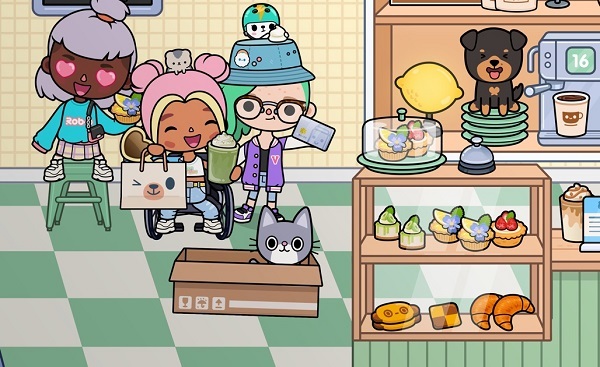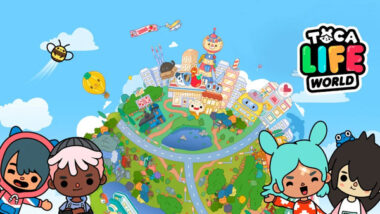Introduction
In Toca Life, players can interact with a variety of items, from school supplies to food, costumes, and household objects, that create a dynamic, interactive world. However, as players explore and collect items across locations, they often face the issue of managing an overflowing inventory. This clutter can make it challenging to navigate spaces, locate desired items, and maintain a smooth gameplay experience. In this article, we’ll dive deeply into the problem of inventory management in Toca Life, providing structured strategies to help players organize and optimize their in-game collections.
Understanding the Inventory Challenge in Toca Life
Inventory management in Toca Life can be overwhelming due to the vast number of collectible items.

Inventory management in Toca Life can be overwhelming due to the vast number of collectible items.
The Endless Collection of Items
Each location in Toca Life offers unique items that players can collect and move between spaces. While this is fun and fosters creativity, it can quickly lead to clutter.
Balancing Item Usage and Storage
While players may enjoy keeping everything, it’s essential to find a balance between which items to keep, use, or store. Too many items can create a chaotic experience.
Setting Up a Central Storage Location
Creating a central storage location allows players to keep frequently used items in one place for easy access.
Choosing the Ideal Location
Select a spot that’s accessible from many areas. The house or school setting is usually an excellent choice for this.
Benefits of Central Storage
Easy Access: Minimizes the need to search multiple areas.
Reduces Clutter: Keeps items consolidated in one area.
Designing the Storage Layout
Use cabinets, closets, and drawers to categorize items by type. For example, keep clothing in one area and food items in another.
Categorizing Items by Type and Use
Organizing items by their purpose can make it easier to find what’s needed.
Grouping Items by Category
Separate items into categories such as food, clothing, toys, and accessories. This way, players can quickly locate what they need.
Suggested Categories
Food and Cooking Supplies
School Supplies and Books
Clothing and Costumes
Seasonal and Occasional Items
Some items, like holiday decorations, don’t need to be readily available. Keep these in a separate storage area to reduce clutter in main areas.
Implementing a Rotation System
A rotation system can keep the game fresh and prevent item overload in any one location.
Rotating Items Regularly
By periodically switching out items, players can make space for new ones without feeling overwhelmed.
Rotation Tips
Weekly Rotations: Change out items every week to keep things organized.
Themed Rotations: Use seasonal themes to decide which items to bring into play.
Using Containers for Easier Rotation
Containers can help players manage items during rotations. Labeling containers also ensures that items return to the right spot when it’s time to swap.
Creating Specialized Rooms for Item Display
A dedicated room or area for displaying collected items allows players to showcase their favorite items.
Benefits of Display Rooms
Instead of storing everything, display rooms let players show off prized possessions without cluttering main play areas.
Ideas for Display Rooms
Museum Style: Display rare or unique items.
Trophy Room: Showcase achievements or special event items.
Organizing Displays by Theme
Keep displays orderly by arranging items by type or theme, such as a “kitchen essentials” corner or “sports equipment” section.
Sorting Items by Character Needs
Assign specific items to certain characters to give them unique identities and reduce clutter.

Assign specific items to certain characters to give them unique identities and reduce clutter.
Character-Specific Inventories
Limit each character’s inventory to items they’ll use or need, like a student with school supplies or a chef with cooking tools.
Assigning Items by Role
Chef: Food and cooking utensils.
Student: Books and school supplies.
Limiting Items Per Character
By restricting characters to a few key items, players avoid overloading spaces and improve gameplay fluidity.
Using Checklists for Better Organization
Checklists help players keep track of items without overwhelming storage areas.
Benefits of Inventory Checklists
A checklist allows players to know what they have and avoid duplicate items. It also helps them keep tabs on where items are located.
How to Create a Checklist
Group by Category: Use separate lists for different item types.
Location-Based Lists: Assign lists to specific locations to avoid duplicates across the map.
Updating Checklists Regularly
As new items are found or old ones discarded, keep the checklist updated to maintain accuracy.
Organizing Seasonal and Event-Specific Items
Holiday and event-themed items often add clutter, but they can be managed with special storage areas.
Storing Seasonal Items Separately
Set up a specific area for items like holiday decorations or seasonal clothing, ensuring they don’t take up space year-round.
Examples of Seasonal Items
Holiday Decorations: Store items like Halloween costumes or Christmas trees together.
Summer Items: Swimsuits, beach toys, etc., can be packed away during the winter.
Swapping Out Seasonally
Rotate items according to seasons to keep the gameplay feeling fresh without overcrowding storage.
Implementing a “One In, One Out” Rule
The “One In, One Out” rule encourages players to think twice before collecting too many items.
Benefits of the “One In, One Out” System
This system helps manage space by ensuring each new item requires removing an old one, keeping clutter to a minimum.
Suggested Usage
New Item Rule: Whenever a new item is added, one must be removed.
Category-Specific Rule: Apply the rule only to categories prone to clutter, like costumes or toys.
Making Trade-Offs Easier
By considering the usefulness of each item, players can make mindful choices that keep their inventory manageable.
Utilizing Virtual Inventory Spaces
For items not in active use, consider using “virtual” inventory methods to keep them from cluttering main areas.
Creating Virtual Inventories
Use containers or storage spaces as placeholders for items not currently needed, treating them as if they’re “off the map.”
Ideas for Virtual Inventories
Storage Bins: Label bins for items like “extra costumes” or “school supplies.”
Hidden Spaces: Use out-of-sight areas like closets to house less-used items.
Rotating Virtual Inventory Items In and Out
When an item is needed again, bring it back into the main game space from its virtual inventory, rotating out something else if necessary.
Maintaining Regular Cleanup Sessions
Setting aside time for cleanup and reorganization can make inventory management easier over time.
Scheduled Cleanup Days
Dedicate certain days to inventory cleanup, sorting, and discarding unnecessary items to keep gameplay streamlined.
Example Schedule
Weekly Cleanups: Quick reorganization of spaces every week.
Monthly Deep Cleans: Remove or rotate items on a larger scale once a month.
Involving All Characters in Cleanup
Involving each character in cleanup sessions not only keeps the space organized but adds a realistic aspect to gameplay, as characters “take care” of their items.

Involving each character in cleanup sessions not only keeps the space organized but adds a realistic aspect to gameplay, as characters “take care” of their items.
Conclusion
Inventory management in Toca Life can seem overwhelming, but with a structured approach, players can maintain a tidy and enjoyable gameplay experience. By establishing central storage, categorizing items, rotating inventories, and creating specialized display areas, players can keep their spaces organized. Whether using checklists, seasonal swaps, or virtual inventories, each method contributes to a smoother and more engaging world. Consistent cleanup sessions and rules, like the “One In, One Out” rule, prevent clutter, helping players focus on the creativity and fun that Toca Life is known for.


